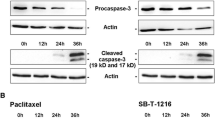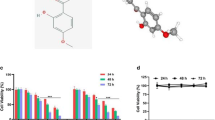Abstract
Quinacrine (QU), a phospholipase-A2 (PLA-2) inhibitor has been used clinically as a chemotherapeutic adjuvant. To understand the mechanisms leading to its chemotherapeutic effect, we have investigated QU-induced apoptotic signaling pathways in human cervical squamous carcinoma Hela cells. In this study, we found that QU induced cytochrome c-dependent apoptotic signaling. The release of pro-apoptotic cytochrome c was QU concentration-and time-dependent, and preceded activation of caspase-9 and −3. Flow cytometric FACScan analysis using fluorescence intensities of DiOC6 demonstrated that QU-induced cytochrome c release was independent of mitochondrial permeability transition (MPT), since the concentrations of QU that induced cytochrome c release did not alter mitochondrial membrane potential (▴ Ψm). Moreover, kinetic analysis of caspase activities showed that cytochrome c release led to the activation of caspase-9 and downstream death effector, caspase-3. Caspase-3 inhibitor (Ac-DEVD-CHO) partially blocked QU-induced apoptosis, suggesting the importance of caspase-3 in this apoptotic signaling mechanism. Supplementation with arachidonic acid (AA) sustained caspase-3 activation induced by QU. Using inhibitors against cellular arachidonate metabolism of lipooxygenase (Nordihydroxyguaiaretic Acid, NDGA) and cyclooxygenase (5, 8, 11,14-Eicosatetraynoic Acid, ETYA) demonstrated that QU-induced apoptotic signaling may be dependent on its role as a PLA-2 inhibitor. Interestingly, NDGA attenuated QU-induced cytochrome c release, caspase activity as well as apoptotic cell death. The blockade of cytochrome c release by NDGA was much more effective than that attained with cyclosporin A (CsA), a MPT inhibitor. ETYA was not effective in blocking cytochrome c release, except under very high concentrations. Caspase inhibitor z-VAD blocked the release of cytochrome c suggesting that this signaling event is caspase dependent, and caspase-8 activation may be upstream of the mitochondrial, events. In summary, we report that QU induced cytochrome c-dependent apoptotic signaling cascade, which may be dependent on its role as a PLA-2 inhibitor. This apoptotic mechanism induced by QU may contribute to its known chemotherapeutic effects.
Similar content being viewed by others
References
Au, J. L., Panchal, N. Li, D., and Gan, Y. Apoptosis: a new pharmacodynamic endpoint.Pharm. Res., 14, 1659–1671 (1997).
Breener C. and Kroimer B. Mitochondria-the death signal integrator. Science, 286, 1150–1151 (2000).
Banerjee, A. K., Willetts, I., Robertson, J. F., and Blamey, R. W.. Pleural effusion in breast cancer: a review of the Nottingham experience.Eur. J. Surg. Oncol., 20, 33–36 (1994).
Cummings, B. S., McHowat, J., and Schnellmann, R. G. Phospholipase A(2)s in cell injury and death.J. Pharm. Exp. Ther., 294, 793–799 (2000).
Corcoran, G. B., Fix, L. Jones, D. P. Moslen, M. T. Nicotera, P. F., Oberhammer, A., and Buttyan, R. Apoptosis: molecular control point in toxicity.Toxicol. Appl. Pharmacol., 128, 168–169 (1994).
de Souza, P. L. Castillo, M., and Myers, C. E. Enhancement of paclitaxel activity against hormone-refractory prostate cancer cells in vitro and in vivo by quinacrine.Br. J. Cancer, 75, 1593–600 (1997).
Farber, J. L., Kyle, M. E., and Coleman, J. B. Mechanisms of cell injury by activated oxygen species.Lab Invest., 62, 670–679 (1990).
Fonteh, A. N., LaPorte, T., Swan D., and McAlexander, M. A. A decrease in remodeling accounts for the accumulation of arachidonic acid in murine cells undergoing apoptosis.J. Biol. Chem., 276, 1439–1449 (2001).
Flynn, J. T. Inhibition of complement-mediated hepatic thromboxane production by mepacrine, a phospholipase inhibitor.Prostaglandins, 33, 287–299 (1987).
Gebbia, N., Mannino, R., Di Dino, A., Maxhouni, L., Bellone, N. Cinque, L., Liuzza, A., La Motta, P., Cannata, G., and Gulotta G. Intracavitary treatment of malignant pleural and peritoneal effusions in cancer patients.Anticancer Res., 14, 739–745 (1994).
Green, D. R. and Reed, J. C. Mitochondria and Apoptosis.Science, 281, 1309–1312 (1998).
Gross, A., Yin, X. M., Wang, K., Wei, M. C., Jockel, J., Milliman, C., Erdjument-Bromage, H., Tempst, P., and Korsmeyer, S. J. Caspase cleaved BID targets mitochondria and is required for cytochrome c release, while BCL-XL prevents this release but not tumor necrosis factor-R1/Fas death.J. Biol. Chem., 274, 1156–1163 (1999).
Huang, C., Ma, W. Y., Li, J., Hecht, S. S., and Dong, Z. Essential role of p53 in phenethyl isothiocyanate-induced apoptosis.Cancer Res., 58, 4102–4106 (1998).
Jan, T. J., Chen, B. H., Ma, S. H., Liu C. L., Tsai, H. P., Wu, H. C., Jiang S. Y., Yang K. D. and Shaio M. F., Potential dengue virus-triggered apoptotic pathway in human neuroblastoma cells: arachidonic acid, superoxide anion, and NF-kappaB are sequentially involved.J. Virology, 74, 8680–8691 (2000).
Kerr, J. F., Wyllie, A. H., and Currie, A. R. Apoptosis: a basic biological phenomenon with wide-ranging implications in tissue kinetics.Br. J. Cancer, 26, 239–57 (1972).
Kim, T. H., Zhao, Y., Barber, M. J., Kuharsky, D. K., Yin, X. M. Bid-induced cytochrome c release is mediated by a pathway independent of mitochondrial permeability transition pore and Bax.J. Biol. Chem., 275, 39474–39481 (2000).
Kluck R. M., Bossy-Wetzel, E., Green, D. R., Newmeyer, D. D., The release of cytochrome c from mitochondria: A primary site for Bcl-2 regulation of apoptosis.Science, 275, 1132–1133 (1997).
Li, H., Kollur, K. S., Gu, J., Dawson, M. I., Cao, X., Hobbs, P. D., Lin, B., Chen, G., Lu, J., Lin F., Xie, Z., Fontana, J. A., Reed, J. C., and Zhang X. Cytochrome c release and apoptosis induced by mitochondrial targeting of nuclear orphan receptor TR3.Science, 289, 1159–1165 (2000).
Lei, W., Yu, R., Mandlekar, S., and Kong A.-N. T. Induction of apoptosis and activation of interleukin 1 beta-converting enzyme/Ced-3 protease (caspase-3) and c-Jun NH2-terminal kinase 1 by benzo(a)pyrene.Cancer Res., 58, 2102–2106 (1998).
Srinivasula, S. M., Datta, P., Fan, Xfernandes-Alnemri., T., Huang Z., and Alnemri E. Molecular determinants of caspase-promoting activity of Smac/DIABLO and its role in the death receptor pathway.J. Biol. Chem., 275, 36152–36157 (2000).
Sluss, H. K., Barrett, T., Derijard, B. and Davis R. J. Signal transduction by tumor necrosis factor mediated by JNK protein kinases.Mol. Cell. Biol., 14, 8376–84 (1994).
Tifani, M., Schneider, T. G., Pastorino, J. G. and Farbaer J. L. Cytochrome c-dependent activation of caspase-3 by tumor necrosis factor requires induction of the mitochondrial permeability transition.Am. J. Pathology., 156, 2111–2112 (2000).
Tournier, C., Hess, P., Yang, D. D., Xu, J., Turner, T. K., Nimnual, A., and Dafna C. Requirement of JNK for stress-induced activation of the cytochrome c-mediated death pathway.Science, 288, (1987).
Thornberry, N. A. and Lazebnik Y. Caspases: enemies within.Science, 281, 1312–1316 (1998).
Tewari, M. L., Quan, T., Desnoyers, O. R. K., S., Zeng, Z., Beidler, D. R G. Poirier, G. G., Salvesen, S., and Dixit, V. M. Yama/CPP32 beta, a mammalian homolog of CED-3, is a CrmA-inhibitable protease that cleaves the death substrate poly(ADP-ribose) polymerase.Cell, 81, 801–809 (1995).
Wallace, D. J., The use of quinacrine (Atabrine) in rheumatic diseases: a reexamination.Semin. Arthritis. Rheum., 18, 282–296 (1989).
Yang, J., Liu, X., Bhalla, K., Naekyung C. K., Ibrado, A. M., Cai J., Peng T., Jones D. P., and Wang, X.Science, 275, 1129–1133 (1997).
Yu, R., Mandlekar, S., Harvey, K. J., Ucker, D. S., and Kong, A.-N. T. Chemopreventive isothiocyanates induce apoptosis and caspase-3-like protease activity.Cancer Res, 58, 402–408 (1998).
Yu, R., Mandlekar, S., and Kong, A.-N., T. Molecular mechanisms of butylated hydroxyanisole-induced toxicity: Induction of apoptosis through direct release of cytochrome c.Mol. Pharmacol., 58, 431–437 (2000a).
Yu, R., Mandlekar, S., Tan, T.-H., and Kong, A.-N.-T. Activation of p38 and c-Jun N-terminal kinase pathways and induction of apoptosis by chelerythrine do not require inhibition of protein kinase C.J. Biol. Chem., 275, 9612–9619 (2000b).
Yu, R., Tan, T. H. and Kong, A.-N. T. Butylated hydroxyanisole and its metabolite tert-butylhydroquinone differentially regulate mitogen-activated protein kinases. The role of oxidative stress in the activation of mitogen-activated protein kinases by phenolic antioxidants.J. Biol. Chem., 272, 28962–28970 (1997).
Author information
Authors and Affiliations
Corresponding author
Rights and permissions
About this article
Cite this article
Fasanmade, A.A., Owuor, E.D., Ee, R.P.L. et al. Quinacrine induces cytochrome c-dependent apoptotic signaling in human cervical carcinoma cells. Arch. Pharm. Res. 24, 126–135 (2001). https://doi.org/10.1007/BF02976480
Received:
Issue Date:
DOI: https://doi.org/10.1007/BF02976480




